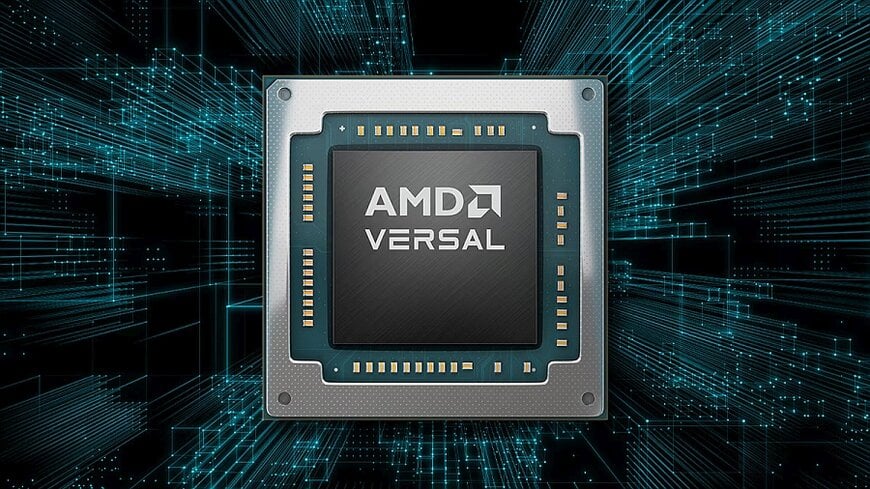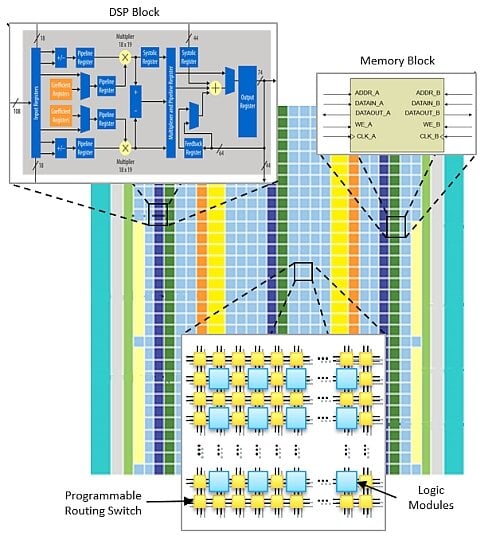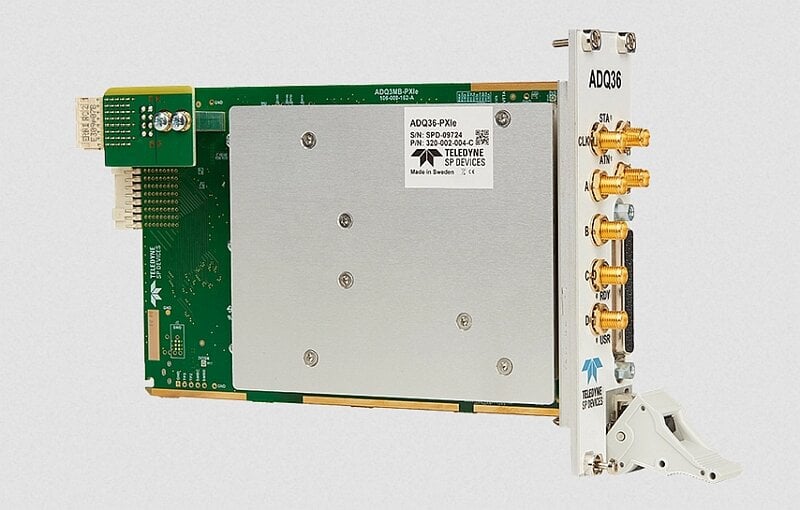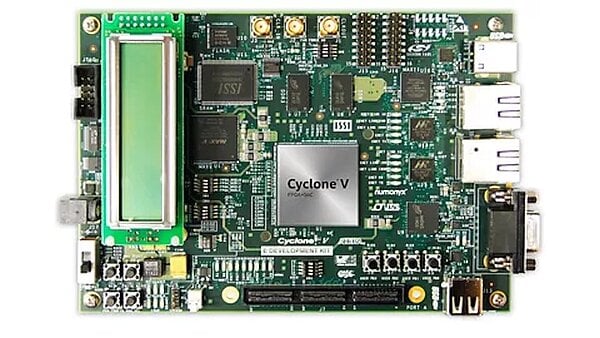Everything You Need to Know About FPGAs
The first FPGA was introduced to the market by Xilinx in 1985. Since then, FPGAs have found their way into a wide range of applications, from high-performance computing and embedded digital processing to integrated circuit prototyping. They stand out for their reconfigurability and significant parallel processing capabilities. Written by Youssef Belgnaoui.

An FPGA (Field-Programmable Gate Array) is a reconfigurable digital integrated circuit that can be programmed after manufacturing. The first FPGA was launched by Xilinx in 1985.
An FPGA is designed to be configured (and reconfigured) in the field. It is not a ready-to-use integrated circuit; it must be configured before use. Unlike a microcontroller or processor, whose operation is fixed, an FPGA can be programmed to execute specific logical functions defined by the user. This enables the creation of custom hardware architectures tailored for signal processing, control, or compute-intensive tasks.
Advantages of an FPGA
- Reconfigurability: They can be reprogrammed as often as needed to adapt to new requirements without modifying the hardware.
- Parallelism: Unlike sequential processors, an FPGA can execute thousands of logical operations simultaneously, making it ideal for real-time processing.
- Low latency: Direct hardware-level processing eliminates the delays typically associated with software execution.
- Rapid prototyping: FPGAs enable quick validation of architectures before developing a dedicated ASIC (Application-Specific Integrated Circuit).
- Longevity: Their reconfigurable nature extends the life of embedded systems by simplifying updates.
Hardware Architecture of an FPGA
An FPGA consists of a network of configurable logic blocks (CLBs) interconnected through programmable routing resources. Each logic block generally includes:
- Logic cells (LUTs – Look-Up Tables) to perform logical operations (AND, OR, XOR, etc.);
- Flip-flops for temporary data storage;
- Sometimes specialised arithmetic blocks (DSP) or embedded memory areas (RAM).
The user defines the configuration of these blocks and their interconnections via a hardware description file (bitstream) loaded into the FPGA’s configuration memory. Some models also integrate embedded processors (such as ARM Cortex cores) or high-speed interfaces to combine software power with hardware flexibility.

Architecture of an FPGA (source: IBM).
Programming an FPGA
FPGA programming is not performed using conventional software languages, but rather with hardware description languages (HDLs) such as VHDL or Verilog. These describe the logical behaviour of the circuit rather than a sequence of instructions. A typical programming workflow includes:
1. Designing the HDL code describing the logic to be implemented;
2. Synthesising the code into a logical network;
3. Placement and routing of blocks within the FPGA;
4. Generating the configuration file (bitstream);
5. Uploading the bitstream to the chip via a JTAG cable or a specific interface.
High-level tools such as Vivado HLS (Xilinx) or Intel Quartus Prime also allow hardware architectures to be designed from higher-level languages like C/C++ or Python.
Main Features of an FPGA
- Digital signal processing (DSP): filters, FFTs, modulation/demodulation;
- Communication interfaces: PCIe, Ethernet, USB, SPI, I²C, etc.;
- Data acquisition and synchronisation: precise clocks, high-speed I/O;
- Parallel computing for embedded AI, image processing, or cybersecurity;
- Redundancy and safety for critical applications (aerospace, defence, space).
Typical FPGA Use Cases
- Test and measurement: signal generation, real-time data acquisition, and test-bench synchronisation;
- Telecommunications: encoding/decoding, modulation, and network protocols;
- Aerospace and space: sensor processing, critical system control, radiation hardening;
- Automotive: advanced driver-assistance systems (ADAS), radar/LIDAR signal processing, driver assistance;
- Embedded AI: acceleration of neural networks;
- ASIC prototyping: validation of specific integrated circuits before fabrication.

Teledyne SP Devices’ ADQ36 signal acquisition board features an AMD Kintex Ultrascale KU115 FPGA, enabling real-time custom signal processing applications.
Main Limitations of FPGA Use
- High unit cost, particularly for high-performance models;
- Higher power consumption compared to optimised ASICs;
- Steep learning curve due to the complexity of HDL programming;
- Design times can be relatively long for complex architectures;
- Limited performance for purely sequential tasks.
Thus, FPGAs are best suited for applications requiring flexibility and customisation, but not necessarily for mass-produced devices with tight cost constraints.
Key Differences Between an FPGA and a Microcontroller
A microcontroller (MCU) executes instructions sequentially according to a stored program. Its architecture (processor, memory, peripherals) is fixed. By contrast, an FPGA implements the hardware itself based on requirements: it does not run code—it *becomes* the circuit. FPGAs offer parallel and real-time processing capabilities, while microcontrollers prioritise simplicity and low power consumption.
Leading FPGA Manufacturers
- AMD (which completed its acquisition of the historic Xilinx brand in 2022): offers the Spartan, Artix, Kintex, and Versal ranges, along with the Vivado environment and SoC solutions (Zynq).
- Altera provides the Cyclone, Arria, and Stratix series, optimised for power efficiency and high-performance computing. Intel acquired the company in 2015, before selling a 51% stake in Altera to U.S. fund Silver Lake in April 2025.
- Lattice Semiconductor: specialises in low-power FPGAs for embedded and IoT applications.
- Microchip (following its acquisition of Microsemi in 2018): known for radiation-hardened FPGAs used in aerospace and defence sectors.
Each manufacturer differentiates itself through design tools, performance, logic density, and the inclusion (or not) of integrated processors (ARM Cortex-A/R/M) for hybrid architectures.
FPGA Pricing
FPGA prices vary widely depending on performance, logic resources (number of logic cells, DSP blocks, embedded memory, high-speed interfaces, etc.), and purchase volume.
Entry-level FPGAs such as Lattice’s iCE40 and MachXO3, AMD’s Spartan-7, and Altera’s Cyclone 10 LP can range from €5 to €50 (in volume) and up to €100 per unit.
Mid-range FPGAs such as AMD’s Artix-7 and Kintex-7, and Altera’s Cyclone 10 GX and Arria V, sell for between €100 and €800 depending on configuration.
High-performance FPGAs such as AMD’s Virtex UltraScale+ and Versal AI Core, or Altera’s Stratix 10 and Agilex, are priced from €1,000 to over €10,000 depending on logic density and integrated interfaces. Prices may exceed €5,000–€10,000 per unit for radiation-hardened or military-grade versions.
Ready-to-use development boards are available from around €50 for entry-level FPGAs up to over €5,000 for high-performance models.

FPGA Cyclone® V E development kit
The Global FPGA Market
According to a study by Allied Market Research, the global FPGA market is expected to grow significantly between 2021 and 2030.
Valued at $7.18 billion in 2020, the FPGA market is projected to grow at an annual rate of 8.4% between 2021 and 2030, reaching $15.89 billion by 2030.
North America held the largest market share in 2020, accounting for more than one-third of global FPGA revenue.
For more information, read the article “FPGA Market Growth Forecast by 2030” published on "electronic journal".

